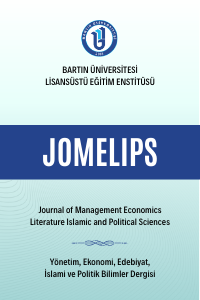Mikrofinansman Kurumu Örneği: Grameen Bank
Bugünün gelişmekte olan dünyasında, yoksul kesimin yaşam standartları yükseltilmedikçe, hiçbir ülkede anlamlı bir kalkınmanın sağlanamayacağı gerçeğini açık bir şekilde kabul edilmiştir. Yoksul kesimin yaşam refahını yükseltme düşüncesi giderek ön plana çıkmaktadır; çünkü sadece büyüme yönlü stratejiler, insanların yaşam şartlarını iyileştirme konusunda önemli ölçüde başarısız olmuşlardır. Bu çalışmada mikrofinans uygulamalarında en başarılı mikrofinansman kurumu olan Grameen Bank’ın ortaya ve gelişimi, amacı ve hedef kitlesi, kurumsal ve faaliyet yapısı, yenilikleri ve finansal yapısı üzerinde durulmuştur. Ayrıca, Grameen Bank sistemleri müşteri türleri, finansal hizmet çeşitleri ve şartları bağlamında ayrıntılı olarak açıklanmıştır. Bu çalışmada, Grameen Bank’ın orataya çıkışı, tarihsel gelişimi, verdiği finansal hizmetler, hizmetinden faydalanan alanlara göre müşteri kesimi ve finansal yapısı hakkında bilgi sunulmuştur.
Anahtar Kelimeler:
Grameen Bank, Yoksulluk, Mikrokredi, Mikrofinans, Bankacılık
Micro Finance Corporation Sample: Grameen Bank
In today's developing world, it is clearly accepted that unless the standards of living of the poor are raised, no meaningful development can be achieved in any country. Poverty is increasingly at the forefront of raising the living prosperity; Because only growth-oriented strategies have been largely unsuccessful in improving people's living conditions. This study focused on the development and development of Grameen Bank, the most successful microfinance institution in microfinance applications, the aim and target mass, institutional and activity structure, innovations and financial structure. In addition, Grameen Bank systems are described in detail in terms of customer types, financial services types and conditions. In this study, information on the customer segment and financial structure of Grameen Bank is presented according to the use of the service, its historical development, the financial services it has provided, and its services.
Keywords:
Grameen Bank, Poverty, Microcredit, Microfinance, Banking,
___
- Khandker, S.R. (1996). Grameen Bank: Impact. Costs. and Program Sustainability. Asian Development Review. Cilt 14. Sayı 1.
- Khandker S.R., 2007. "Coping with flood: role of institutions in Bangladesh," Agricultural Economics, International Association of Agricultural Economists, vol. 36(2), pages 169-180, 03.
- Khandker, Shahidur R. & Khalily, M. A. Baqui & Samad, Hussain A., 2010. "Seasonal and extreme poverty in Bangladesh : evaluating an ultra-poor microfinance project," Policy Research Working Paper Series 5331, The World Bank.
- Sarker, A.E. (2001). The Secrets of Success: The Grameen Bank Experience in Bangladesh. Labour and Management in Development Journal. Asia Pacific Pres: Cilt 2. Sayı 1.
- Mainsah, E., Heuer, S. R., Kalra, A., & Zhang, Q. (2004). Grameen Bank: Taking capitalism to the poor. Chazen Web Journal of International Business, 1-28.
- Johannsen, J., & Zeller, M. (2006, August). Operational Poverty Targeting by the Means of Proxy Indicators-The Example of Peru. In Contributed paper for presentation on the International Association of Agricultural Economists Conference, Gold Coast, Australia.
- Todaro, M.P. & Stephen, C. S. (2002). Economic Development. 9.Basım, USA:Pearson
- Todaro, M. P., & Smith, S. C. (2005). Economic Development 9th edition Addison Wesley.
- Todaro, J. B., & Smith, M. (2006). Training library staff and volunteers to provide extraordinary customer service. Neal Schuman Pub.
- Yunus, M. (2000). Banker to the Poor . The University Press Limited, Dhaka.
- Yunus, M. (2002). Grameen Bank II: Designed to Open New Possibilities, October. Yunus, M. (2003). Some Suggestions on Legal Framework for CreatingMicrocredit Banks, Grameen Bank, July.http://www.grameen.com/
- http://www.grameen.com/index.php?option=com_content&task=view&id=179&Itemid=424
- Başlangıç: 2016
- Yayıncı: Bartın Üniversitesi
Sayıdaki Diğer Makaleler
Ekolojik Sistem Yaklaşımı Üzerine Bir Olgu Sunumu: Suça Sürüklenen Çocuk ve Ailesiyle Çalışma
Trabzon Rum İmparatorluğu Hakkında Bir Bibliyografya Denemesi
Türkiye'de Yükselen Bir Turizm Çeşidi: Helal Turizm
Satın Alma Gücü Paritesinin Azerbaycan Cumhuriyeti için Geçerliliğin Analizi
Basti ALİYEVA, Arzuman HÜSEYNOV
Mikrofinansman Kurumu Örneği: Grameen Bank
Nurhodja AKBULAEV, Turan AHMEDOV, Yusif ALİYEV
İslam’da Sosyal Politika Kapsamında Sosyal Girişimciliğin Değerlendirmesi
Helal Otel İşletmeleri İçin Bir Pazar Genişletme Stratejisi Olarak İşbirlikçi Pazarlama
